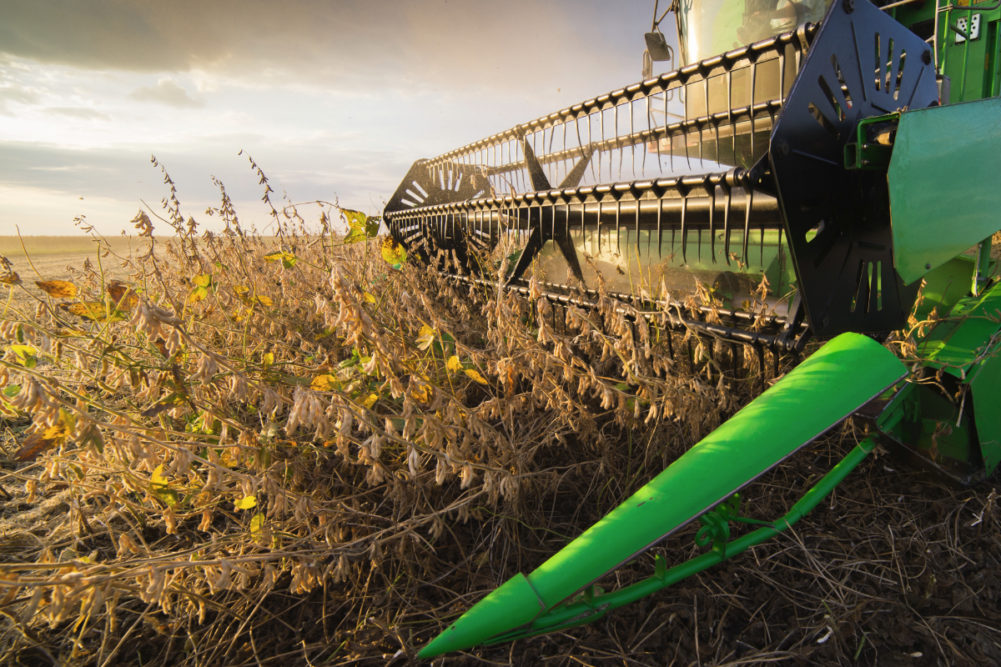KANSAS CITY, MISSOURI, US — As the last of the 2020 spring wheat crop was stowed on farms and at elevators, grain and oilseeds producers across the nation pivoted fully to combining corn and soybeans.
So far, the task has been a relative breeze compared with the frustrating hand dealt to farmers in 2019.
“Producers have the itch to go and get it done,” a veteran Upper Midwest commodities analyst said. “Last year was so rainy and wet. It started to rain, and farmers never got a chance to get after it. And then it was wet in a lot of places this spring. Now, weather is ideal, so when producers get a chance to go, they’re going to go.”
Soybean harvest completion was ahead of corn collection as of Sept. 27, the US Department of Agriculture said in its weekly Crop Progress report. The soybean harvest in the 18 principal production states advanced 14 percentage points in the latest week to 20% harvested, ahead of 6% a year earlier and 15% as the recent five-year average for the date.
The soybean harvest was expanding from the South into the Central states and even the Upper Midwest.
North Dakota producers for the most part had their spring and durum wheat packed away and were in the fields collecting soybeans. The USDA said 27% of the North Dakota crop was harvested, well ahead of 3% a year earlier and 19% as the five-year average progress.
“They were getting after it in the dark by the headlights of their combines last week between Jamestown and Fargo,” the analyst said. “And leaving a big old dust bowl behind them because it’s so dry. They want to go and get it while they can, and it is dry and looking good for them.”
Thus far, neither diseases nor pests were proving problematic to US soybeans. However, it was apparent to crop experts at country elevators that overnight freeze events beginning Sept. 9 had hindered growth for some soybeans in North Dakota and Minnesota.
“North Dakota got nipped a couple days the week before last,” a crop expert said. “That hurt some of their soybeans. It’s pretty uniform. Some soybeans in southwestern North Dakota are pretty small. Going a little bit farther north, soybeans at one elevator were kind of green and yellow. Some of the green will turn. Yields are anywhere from 30 to 50 bushels an acre.”
Overall, soybean yields so far were better than growers expected.
“After producers got that frost, they thought, ‘Oh man, we’re done for. We won’t get any beans at all,’” the analyst said. “But there are some fields with yields really low, some that are really dry, and there’s some that are just kind of average. When soybeans get down to 8%, 9% moisture, they just break up. Their shells pop off. So growers don’t want them too dry.”
Reports from Wilton, North Dakota, US, about 20 miles north of Bismarck, North Dakota, US, were of good-quality soybeans, decent yields and very few green plants. Yields in south-central Minnesota near Mankato mostly ranged from 50 to 70 bushels an acre.
Minnesota soybean harvest completion jumped 24 percentage points in the latest week to 31%, ahead of 4% a year earlier and 18% as the average.
Some growers temporarily may have switched to harvesting corn after witnessing lengthy lines to dump soybeans at elevators.
“They’ll go back and forth if they can’t dump or if they run into other issues,” the analyst said. “For example, if their soybeans are too wet, they’ll leave them for a week. Or if their corn is too wet, but they’ve got favorable weather, they’ll go try something else and come back to that corn.”
Meanwhile, the 2020 US corn harvest also was gathering steam and reached 15% completion by Sept. 27 in the 18 principal production states, ahead of 10% a year ago and close to 16% as the 2015-19 average for the date.
Furthest along were states in the South (Texas, 70% completed), East Coast (North Carolina, 74%) and mid-South (Kentucky, 54%). The nation’s top corn production state, Iowa, had cut about 12% of its crop, well ahead of 1% last year and 5% as the average despite the challenges deriving from a destructive “derecho storm” that brought intense wind and thunderstorms to a 700-mile swath from Nebraska to Indiana on Aug. 10.
“Some of the guys in Iowa are having a heck of a time picking up the corn that got blown over,” the analyst said. “Yields aren’t terrific in those areas. They’re trying to see how low they can get the head on the combine to try to pick it up, and sometimes coming back through the opposite direction of the way it’s laying to try to pick it up.
“But outside those storm-damaged areas, corn is drying down nice and looking good.”
Corn harvest completion by Sept. 27 was 29% in Kansas (35% as the average for the date), 13% in Colorado (7%), 14% in Nebraska (10%), 10% in South Dakota (5%), 11% in Illinois (16%), 17% in Indiana (15%), 13% in Ohio (12%) and 13% in Michigan (8%).




